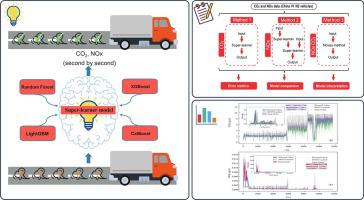Environment International ( IF 10.3 ) Pub Date : 2021-11-11 , DOI: 10.1016/j.envint.2021.106977 Ning Wei 1 , Qijun Zhang 1 , Yanjie Zhang 1 , Jiaxin Jin 1 , Junyu Chang 1 , Zhiwen Yang 1 , Chao Ma 1 , Zhenyu Jia 1 , Chunzhe Ren 1 , Lin Wu 1 , Jianfei Peng 1 , Hongjun Mao 1

|
The transient simulation of CO2 and NOX from motor vehicles has essential applications in evaluating vehicular greenhouse gas emissions and pollutant emissions. However, accurately estimating vehicular transient emissions is challenging due to the heterogeneity between different vehicles and the continuous upgrading of vehicle exhaust purification technology. To accurately characterize the transient emissions of motor vehicles, a Super-learner model is used to build CO2 and NOx transient emission models. The actual onboard test data of 9 China VI N2 vehicles were used to train the model, and the test data of another China VI N2 vehicle were selected for further robustness verification. There were significant differences in the emissions between the vehicles, but the constructed transient model could capture the common law of transient emissions from China VI N2 vehicles. The R2 values of CO2 and NOx emission in the test data of the validation vehicle were 0.71 and 0.82, respectively. In addition, to further prove the model's robustness, the training data were synchronously modelled based on the Moves-method. The Super-learner model has a smaller RMSE on the validation set than the model based on the Moves-method, indicating that the Super-learner model has more transient simulation advantages. The marginal contributions of the model characteristics to the model results were analysed by SHapley Additive exPlanation (SHAP) value interpretation, and the marginal contributions of different pollutant characteristic parameters varied. Therefore, when establishing transient models of different pollutants, the selection of the model parameters demands considering the generation and purification process of different pollutants. The present work provides novel insights into the parameter selection, construction, and interpretation of the transient vehicle emission model.









































 京公网安备 11010802027423号
京公网安备 11010802027423号